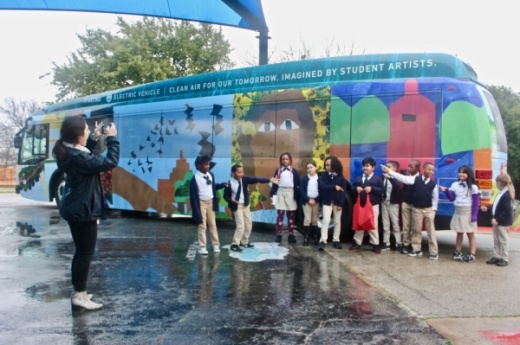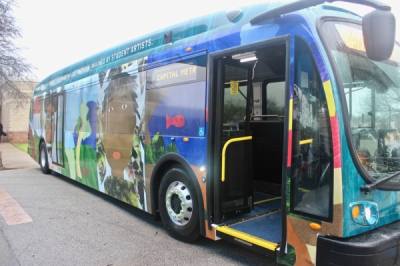The goal, said Dottie Watkins, the transit agency’s chief operating officer and chief customer officer, is to eventually replace all of the agency's 423 diesel buses with a zero-emission version. Each bus costs about $1 million, which includes the battery charger, she said.
"It's just become part of our way of thinking about how we want to power the fleet as we really intend to only buy zero-emission vehicles going forward," Watkins said.
Capital Metro unveiled the first two buses Jan. 22 at Lee Lewis Campbell Elementary Media and Performing Arts Institute in East Austin. The buses feature the artwork of 23 students who won a contest led by arts-focused nonprofit Creative Action. The students’ artwork is featured on the two buses, which will rotate among the agency’s routes, Watkins said. The remaining eight buses from the initial purchase will be in operation by this spring, she said.
This fall, the first phase of the renovation project at the agency’s North Operations facility will be complete and provide additional charging stations for future buses, Watkins said.
Capital Metro President and CEO Randy Clarke said an electrified fleet ties into the agency’s vision for Project Connect, the regional transit plan that includes more high-capacity buses and/or rail.
“We all know climate change is a real threat, and what we’re doing here at Cap Metro is not only this electric program right now, but we also know we have to build a much bigger transit system,” he said. “We need to do that for all the hard-working teachers and faculty of a school like this, the parents. As our city continues to grow and our traffic keeps getting worse, we have to have a more sustainable and better mobility system.”
The electric buses will also provide riders with a smoother and quieter ride, said Ryan Popple, the president and CEO of California-based Proterra, which engineers and manufactures the buses.
He said the electric buses are made from a lightweight carbon composite, similar to material used for the blades of wind turbines, for the exterior of the buses.
Each bus has four 9-by-3-foot batteries that generate 110 kilowatt hours. In total, the batteries weigh 6,000 pounds, he said. The lithium-ion batteries are similar to those found in consumer electronics, he said.
"Sometimes it's not necessarily about inventing the light bulb," he said. "Sometimes it's figuring out how to make a safer, cleaner, better business model for light bulbs. ... We hope that we can be a part of an incredibly energy-efficient, clean, quiet, scaling local transit solution."
These buses use about 2 kilowatt hours per mile, so it is possible for the buses to go up to 165 to 200 miles on a single charge. Popple said the range depends on a variety of factors, such as weather and how a driver operates the bus. Proterra is also providing training to Capital Metro drivers to learn how the buses accelerate and decelerate differently from diesel buses.







